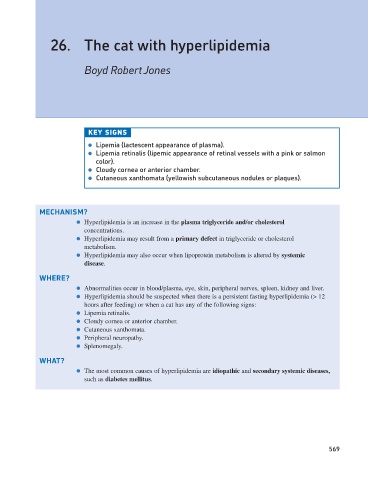Page 577 - Problem-Based Feline Medicine
P. 577
26. The cat with hyperlipidemia
Boyd Robert Jones
KEY SIGNS
● Lipemia (lactescent appearance of plasma).
● Lipemia retinalis (lipemic appearance of retinal vessels with a pink or salmon
color).
● Cloudy cornea or anterior chamber.
● Cutaneous xanthomata (yellowish subcutaneous nodules or plaques).
MECHANISM?
● Hyperlipidemia is an increase in the plasma triglyceride and/or cholesterol
concentrations.
● Hyperlipidemia may result from a primary defect in triglyceride or cholesterol
metabolism.
● Hyperlipidemia may also occur when lipoprotein metabolism is altered by systemic
disease.
WHERE?
● Abnormalities occur in blood/plasma, eye, skin, peripheral nerves, spleen, kidney and liver.
● Hyperlipidemia should be suspected when there is a persistent fasting hyperlipidemia (> 12
hours after feeding) or when a cat has any of the following signs:
● Lipemia retinalis.
● Cloudy cornea or anterior chamber.
● Cutaneous xanthomata.
● Peripheral neuropathy.
● Splenomegaly.
WHAT?
● The most common causes of hyperlipidemia are idiopathic and secondary systemic diseases,
such as diabetes mellitus.
569

